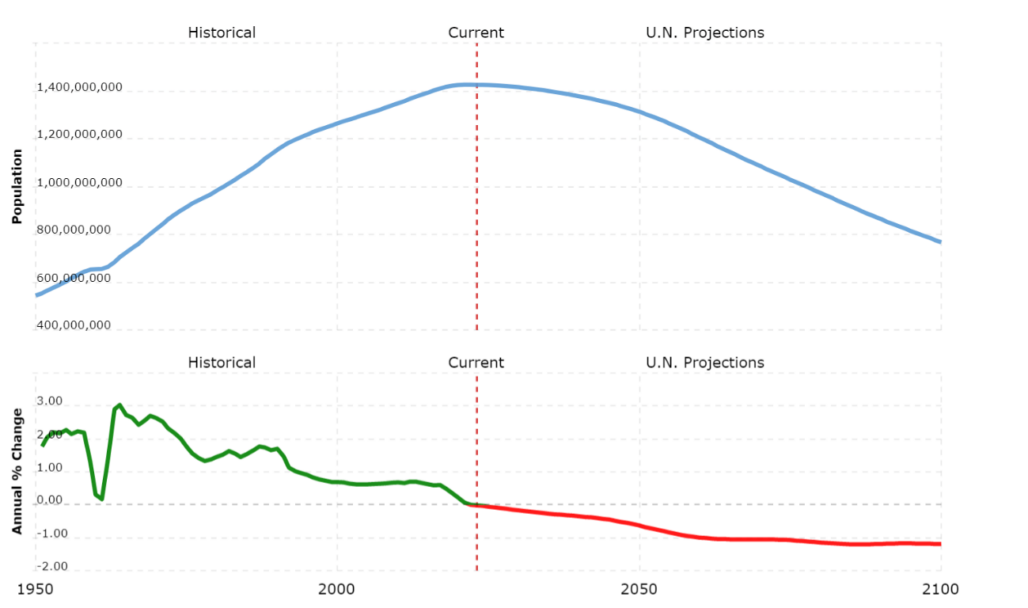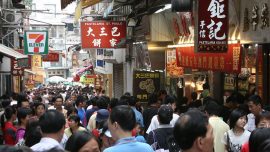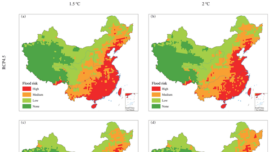
By Jorge Costa Oliveira
Partner and CEO of JCO Consultancy
According to China’s National Bureau of Statistics, in 2022 the Chinese population was 1,411.75 million, having declined by c. 850,000 people. It is the biggest reduction in Chinese population since the Great Leap Forward, which triggered the Great Famine of 1960-1962 that claimed >30 million lives. In 2022, the number of births was 9.56 million and the number of deaths 10.41 million, with birth rates of 6.77‰, mortality rates of 7.37‰ and natural population growth of -0, 60‰.
The UN estimated that, if China’s fertility rate remains at a very low level (1,15/woman, although only 0.7/woman in Beijing or Shanghai) and the country does not attract immigrants (China has one of the lowest rates of immigrants in the total resident population – 0.1%), the Chinese population could contract to around 767~775 million in 2100. UN experts reformulated the initial estimates and, based on the 2020 Census, revised China’s population by -18.5 million and declining by 109 million by 2050 (more than triple the decline of its previous forecast in 2019). According to the Shanghai Academy of Social Sciences, China’s population may decline to only 587 million by the end of the century. Moreover, in China, the legal retirement age is low (60 years for men; 50~55 years for women) and comes from a period when the life expectancy was much lower than the current one (the Chinese government has already announced the gradual extension of these ages).


This reduction in the Chinese national population marks the beginning of China’s population decline and accentuates its ageing. Credible sources (Airfinity, Wigram and FT) also estimate that the deaths resulting from the waves of covid-19 infections after December 2022 exceed one million lives, contributing to an additional decrease in the population in 2023.

The aging of the population increases the burden on social security for the elderly, reduces the propensity to save and has other negative effects that the Chinese government will not be able to easily mitigate.
The 1,73% average annual decline in China’s working-age population is likely to lead to lower economic growth unless productivity rises rapidly (unlikely). The reduction of the working-age population has led the Chinese government to change its economic focus. China’s 14th Five-Year Plan focuses on orienting the economy for its domestic market and towards the production of goods with higher added value rather than the production of intermediate goods in the global supply chain. This transformation takes time.

However, internal migration from the countryside to the cities remains strong (in 2022 there were 920 million people in Urban China, with an annual growth of 0.5%) and will allow to mitigate, in the short term, the effects of the gradual reduction of the active population resulting from the population decline. Nonetheless, many Chinese companies producing manufactured goods are already rapidly relocating to Bangladesh, Pakistan, Vietnam and Africa.

One of the sectors where there will be implications in the short term is construction and real estate (responsible for c. 25% of China’s GDP). According to a forecast made by the Beike Research Institute, demand for residential real estate in China is expected to continue to decline – on average -2.5%/year until 2035 – as the demographic dividend declines. Although some analysts believe that the real estate market will not fall sharply, the annual demand for new housing is expected to fall to 1.3 billion m2 by 2035, from an average of 1.9 billion m2 between 2016 and 2020.
Overall, one may summarize, with HSBC’s chief economist for Asia, Frederic Neumann, that “the Chinese economy is entering a critical transition phase, and can no longer count on an abundant and cost-competitive workforce to drive industrialization and growth” [based on the production of intermediate goods in the global supply chain]. To avoid an economic slowdown and an industrial recession in the country – predicted by Yi Fuxian, an expert demographer, as a result of population decline – the Chinese government, in line with an increase in professional qualifications of the less elderly generations, intends to upgrade the Chinese industry focusing on the production of goods with higher added value, with a view to positioning China as a global power in high-tech industries, betting on the priority sectors identified in the Made in China 2025 program.
The Chinese government is creating incentives for an increase in the fertility rate; but no one envisions a level of success different from [the poor results of] similar programs in other countries with declining (and aging) populations. There is another way out of this demographic decline conundrum, that consists in increasing significantly immigration into China. An active immigration policy can reduce China’s population decline. But in times of exaltation of Han ethnic nationalism, strongly stimulated by the authorities, will the Chinese government be able to adopt a policy of attracting immigrants to restore balance in a number of economic sectors?























